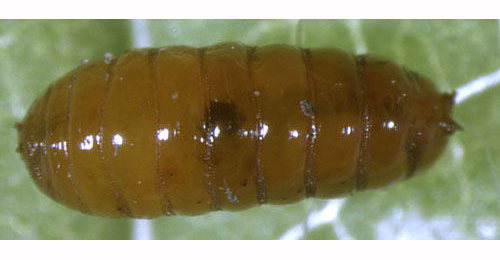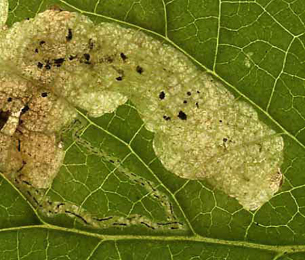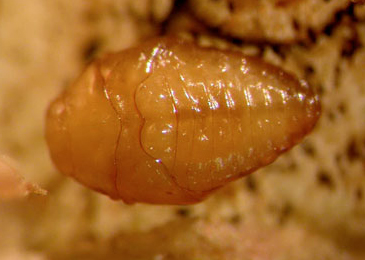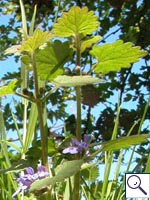|
||||||
|
GLECHOMA. Ground-ivy. [Lamiaceae] |
|
|
Ground-ivy (G. hederacea) is the only species of Glechoma recorded in Britain. It is a native species. Ten British miners are recorded on Glechoma. Elsewhere the agromyzid Napomyza nigriceps feeds in the stems of Glechoma. A key to the European miners recorded on Glechoma is provided in Bladmineerders van Europa. |
|
| |
|
Key for the identification of the known mines of British |
Note: Diptera larvae may live in a corridor mine, a corridor-blotch mine, or a blotch mine, but never in a case, a rolled or folded leaf, a tentiform mine or sandwiched between two more or less circular leaf sections in later instars. Pupation never in a cocoon. All mining Diptera larvae are leg-less maggots without a head capsule (see examples). They never have thoracic or abdominal legs. They do not have chewing mouthparts, although they do have a characteristic cephalo-pharyngeal skeleton (see examples), usually visible internally through the body wall. The larvae lie on their sides within the mine and use their pick-like mouthparts to feed on plant tissue. In some corridor miners frass may lie in two rows on alternate sides of the mine. In order to vacate the mine the fully grown larva cuts an exit slit, which is usually semi-circular (see Liriomyza huidobrensis video). The pupa is formed within the hardened last larval skin or puparium and as a result sheaths enclosing head appendages, wings and legs are not visible externally (see examples). See Key to non-Diptera. |
1a > Leaf-miner: A distinctive mine primarily above mid-rib, with irregular short lateral offshoots into leaf blade. Pupation external (Spencer, 1972: 51 (fig. 172), 55; Spencer, 1976: 270, 271 (fig. 486)). Branched, whitish, upper-surface corridor; main axis overlying the midrib; side branches overlying the main lateral veins. (In Campanula and Phyteuma the mine is much less branched, sometimes nothing more than a corridor on top of the midrib). Frass in rather long strings. Usually the mines begins as a long and narrow, shallow, tortuous lower-surface corridor that ends upon the midrib but otherwise is not associated with the leaf venation. Often this initial corridor is filled with callus, and then even less conspicuous. Pupation outside the mine. A linear mine on the upper surface, usually following the midrib and showing side branches along the veins. The frass is in strings. |
|
Liriomyza strigata (Meigen, 1830) [Diptera: Agromyzidae]. |
1b > Leaf-miner: A linear-blotch mine, first instar mine is linear, later developing into a conspicuous white blotch. Frass greenish diffused (Spencer, 1972b: 46, 47 (fig. 138); Spencer, 1976: 166). The mine begins with a long, upper-surface, slender corridor. After a moult the larva changes its behaviour, and makes a large, upper-surface primary blotch without apparent feeding lines. Often the blotch overruns more or less the initial corridor. Frass in the corridor liquified to form a wide green band, with a few tiny black granules along the sides. Pupation outside the mine. A narrow gallery leading to a largish blotch on the upper surface. Frass is green and indistinct in the gallery - small grains may be seen at the gallery edge. |
 Amauromyza labiatarum puparium Image: © Willem Ellis (Bladmineerders van Europa) |
|
Amauromyza labiatarum (Hendel, 1920) [Diptera: Agromyzidae]. |
1c > Leaf-miner: Initially a long, slim corridor, the frass alternating on either the side of the corridor. After moulting, the larva broadens the mine and the frass is less regular. Pupation external. |
 Mine of Amauromyza lamii on Stachys sylvatica Image: © Willem Ellis (Bladmineerders van Europa) |
|
Amauromyza lamii (Kaltenbach, 1858) [Diptera: Agromyzidae]. |
1d > Leaf-miner: An initially linear mine, which at second instar develops into a large whitish blotch with conspicuous black frass. The early linear mine is frequently entirely enveloped by the blotch but is detectable by the alternate irregular strips of frass. Pupation external (Spencer, 1976: 158). The first part of the mine consists of a long, slender upper-surface corridor. After the first moult this changes into a large primary blotch without feeding lines. Frass in the corridor in short, somewhat angular thread fragments, towards the end even in grains. Frass arranged less closely along the sides than in A. lamii. Pupation outside the mine. The frass is conspicuous in the mine and the mine is initially linear, then develops into a white blotch, often enveloping this early mine. |
|
Amauromyza morionella (Zetterstedt, 1848) [Diptera: Agromyzidae]. |
| 1e > Leaf-miner: A
blotch-mine invariably adjoining margin of leaf (Spencer,
1976: 110, fig. 105).
Upper-surface, yet rather deep, therefore quite transparent, blotch, always along the leaf margin, generally in the distal half of the leaf. The blotch is preceded by a short and broad corridor, most of the time overrun later. Four to eight larvae may co-occur in a leaf. Pupation outside the mine, exit slit in lower epidermis. Puparium reddish brown or reddish-orange |
|
Agromyza flavipennis Hendel, 1920 [Diptera: Agromyzidae]. |
1f > Leaf-miner: A distinctive mine with a short linear section at the beginning, then winding and forming a secondary blotch and finally a short straighter end section. Pupation internal or more normally the puparium falls to the ground (Spencer, 1972b: 96 (fig. 96), 97; Spencer, 1976: 324 (fig. 738). The mine begins as a narrow corridor, with the frass in fine grains along the sides. In the next section the corridor is much wider and more closely wound, forming a secondary blotch; the frass now forms pearl chains. In the final section the corridor is again narrower, rather straight and especially interparenchymatous, greenish in transparency. Pupation outside the mine, but the puparium often sticks to the leaf. A short upper surface gallery, then winding to form a blotch; finally becoming linear again- the last section being shallow and looking green. |
|
Phytomyza glechomae Kaltenbach, 1862 [Diptera: Agromyzidae]. |
| 1g > Leaf-miner: Full depth, initially a much branched corridor, irregular in width, in the end almost a blotch. The mine has openings by which part of the frass is ejected. The larvae frequently leave the mine to restart elsewhere. Older larva live free and cause window feeding, often erasing their old mines. In Coltsfoot also pseudo-mines are made, when the larva eats away the lower epidermis with the leaf tissue, but spares the dense hair cover. |
|
Phytosciara halterata Lengersdorf, 1926 [Diptera: Sciaridae]. |
|
Key for the identification of the known mines of British |
Note: The larvae of mining Coleoptera, Hymenoptera and Lepidoptera may live in a corridor mine, a corridor-blotch mine, a blotch mine, a case, a rolled or folded leaf, a tentiform mine or sandwiched between two more or less circular leaf sections in later instars. Larva may pupate in a silk cocoon. The larva may have six legs (although they may be reduced or absent), a head capsule and chewing mouthparts with opposable mandibles (see video of a gracillarid larva feeding). Larvae of Hymenoptera and Lepidoptera usually also have abdominal legs (see examples). Frass, if present, never in two rows. Unless feeding externally from within a case the larva usually vacates the mine by chewing an exit hole. Pupa with visible head appendages, wings and legs which lie in sheaths (see examples). |
1a > Leaf-miner and case-bearer: The larva lives outside the mine, protected by a case, and feeds on the underlying plant tissues via a hole cut in the epidermis. From that point it eats away as much leaf tissue as it can reach without fully entering the mine. Mine does not contain frass (Coleophora species). Blotch mines reaching the edge of the leaf, initially pale green turning brownish white, are caused by the larva feeding on the underside of a leaf. The fully developed case is slender, shining black brown, about 9 mm long. Towards the end a na |
|
Coleophora albitarsella Zeller, 1849 [Lepidoptera: Coleophoridae]. |
1b > Leaf-miner, but not a case-bearer |
2a > Leaf-miner: Rather long full depth corridor that winds freely through the leaf and may cross itself. In the end the corridor widens considerably. Frass mostly in a narrow central line, but may also be deposited along the sides or be missing. The larvae regular leave a mine to restart elsewhere. Pupation outside the mine. Neither larva or mine can be distinguished from that of related species. |
|
Apteropeda orbiculata (Marsham, 1802) [Coleoptera: Chrysomelidae]. |
2b > Leaf-miner: Upper-surface, transparent blotch that begins at the leaf margin, generally at the underside of the leaf. Oviposition site covered by a shining brown drop of hardened secretion. Frass in grains or thread fragments. |
 Trachys scrobiculatus pupa, dorsal Image: © Jean-Yves Baugnée (Bladmineerders van Europa) |
|
Trachys scrobiculatus Kiesenwetter, 1857 [Coleoptera: Buprestidae]. |
| Last updated 05-Jul-2019 Brian Pitkin | ||

